AGRONOMIC UPDATE – August 15, 2022….A Break in the Temps….
Topics:
- Growing Degree Unit Update
- Quick Crop Update/Water Use/Weather
- Impact of Pivot Issues
- Corn/Soybean Insect Update
- Enlist E3 Soybeans and Weed Control System
TEMPERATURES & GDU ACCUMULATION:
As of August 14th, we have accumulated approximately the following for Growing Degree Units in 2022:
Planting Date GDD’s2022 Average GDD Departure from average
April 21 2228 2198 +30 (+ 1.5 days)
April 28 2162 2148 +14 (even)
May 9 2099 2054 +45 (+ 2 days)
The above numbers continue to show us slightly ahead of normal for GDU accumulation since the last update 12 days ago. Average daily GDU accumulation the past 12 days has been 23. Average daily GDU accumulation over the next 14 days is forecasted to be 19, so we will definitely slowdown over the rest of the next two weeks if forecast holds true. Forecast for GDU accumulation over the next two weeks is 274 GDUs. If this holds true, this would give us 2502 GDU’s by September 1 for an April 21 planting date and 2328 GDU’s for a May 9 planting date. For perspective, it takes approximately 2550 GDU’s for P1082AM to reach maturity and 2760 GDU’s for 1366AM. The cooler temperatures will give the crop a break and extend the grain-fill period which is normally a very good trend for yields. More info in the weather update below.
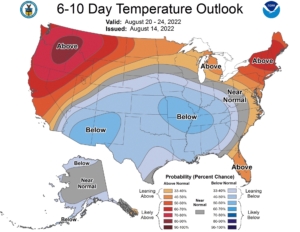

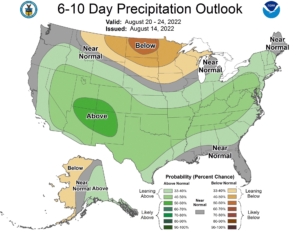
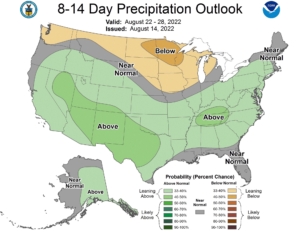
The above the 6-10 and 8-14 day forecasted temperature and precipitation maps. As you can see from the maps, we are forecasted to be normal to slightly below normal for temperatures through the rest of this month, and normal to below normal precipitation. The cool temps will slow down development and reduce irrigation needs, however, they will increase the potential for more late-season disease pressure to show up as cool temps means more dew and wet crop canopy’s. Usually cool temps means more cloudy weather, so we will see what happens to sunlight over the next few weeks. Much of the April planted corn crop is in the Dough to Beg. Dent stage, with some early maturity hybrids at 1/8 milk line. The May planted crop is in the late-Milk to Dough stage. Most soybean fields are in the R5 (Beg. Seed) to R6 (Full seed) stage.
WEATHER/CROP WATER UPDATE
- Relative Humidity – RH has been running 10% below normal through the first half of August. This has influenced a couple of things….it has reduced potential disease outbreaks but has increased crop ET rates and the potential for increased numbers of spider mites. From the above forecasts, expect RH to increase the rest of this month, increasing disease potential but lowering crop ET rates.
- ET rates – ET rates over the past 14 days have averaged .30 inch/day versus a normal of .25 inch/day, or a total of 4.25″. This is equivalent to roughly 7 circles in 14 days @ .60″/circle. ET rates over the past 30 days have also been .30 inch/day. ET usage for 2022 over the past 30 days has been equal to the 2012 growing season so far. As such, it has been difficult to increase soil moisture profiles in this time frame. It has been especially hard to shut down much at all in the sandier soils. This has been driven higher by the lower RH and hot temps. However, the cool temps forecasted should lower the ET rates over the next two weeks, this will extend out the irrigation season but will at least give our wells a break…hopefully our rain chances and amounts will increase also. The below charts are Crop Water Usage for corn and soybeans during the reproductive phases of growth. From the tables below, current corn and soybean needs are still in the 6-8 inch range to finish the crop depending upon temperatures, RH, etc.
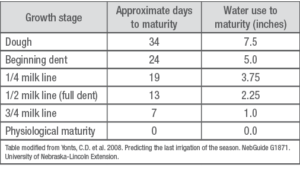
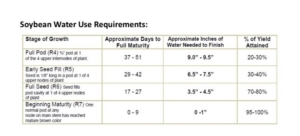
- Sunlight – As always sunlight becomes a huge player during grain-fill for both yield and late-season plant health. Sunlight over the past 14 days and the past 28 days has been 3.5% above normal. This trend is very similar to 2021 but is still below the peak of 2012. This should be a positive to yield. On the flip side, with cooler temps usually comes increased cloudy weather. If this occurs, and for how long of time, will determine any impact on kernel size/test weights plus any impact on late-season plant health. Hopefully, we still get a lot of sun in the cool temperatures….
- Temperatures – The first half of August saw above average daily high and low temperatures. Average Daily High was 4 degrees above normal and Average Daily Low as .5 degrees above normal. Once temperatures get over 85 degrees photosynthesis slows down…the higher the temp, the slower the rate. Let’s hope that in the cooler temps it is still sunny as overall photosynthesis rate will be higher.
IMPACT OF SPRINLER ISSUES & OTHER PIVOT PROBLEMS
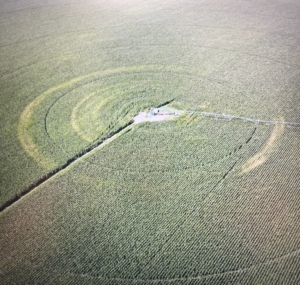
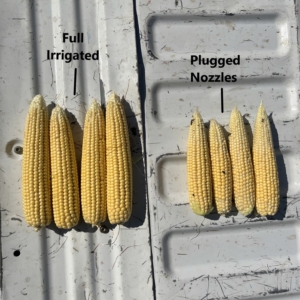
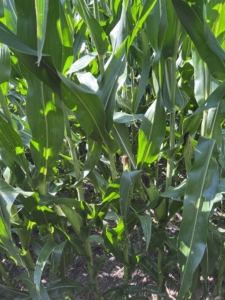
 Photos courtesy of Peter Starman
Photos courtesy of Peter Starman
Above photo is a drone picture showing sprinkler issues, be it plugged nozzles or pressure regulators. Just as in 2012, we are seeing a few more of these issues crop up. The photo of the ears shows the difference from the good irrigated versus the sprinkler ‘rings’. The other two photos are pictures of the plant canopy within the good irrigated versus the ‘rings’. Just ‘food for thought’ as you finish the irrigation season and move into harvest and plan for next year….
CORN/SOYBEAN INSECT UPDATE
- Spider Mites – We are finding more spider mite colonies, mostly in sandier fields, than the prior few years. The weather conditions this year has been conducive for an increase in infestations of this insect. The cooler temps and dewy mornings should slow this insect down….plus, in these conditions, a natural fungus starts which drops their populations down. We still have a month of grain fill left, so keep an eye out for this pest to keep it from ‘turning’ your corn field too ‘fast’.
- European Corn Borer – Still seeing very little in the way of ECB. However, we just started to see moths fly this week, so expectations are for an increase. If you have popcorn or conventional corn acres, keep this pest in mind also.
- Soybean pests – so far, insect activity in soybeans continues to be very light. We are not seeing much for soybean aphids or bean leaf beetles so far. Expectations for major outbreaks of these pests are low…
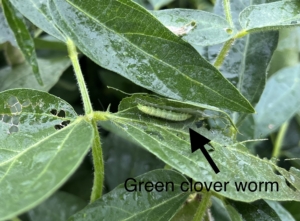
One pest you may run across in your soybeans is the Green Cloverworm. This insect is in most soybean fields every year, but is usually not an economic pest. It wraps itself up similar to a Painted Lady. Numbers are very low, but, since there is not much activity, you may notice this one…
ENLIST E3 SOYBEANS AND ENLIST WEED CONTROL SYSTEM
Introducing the Enlist E3 Soybeans from Pioneer. Enlist herbicide was approved for Antelope County last spring and the Enlist technology is available to spray going forward into 2023..
Pioneer Brand A-Series Enlist E3 Soybeans – These are exclusive, next-generation varieties that combine the world-class Pioneer genetics of A-Series soybeans with Enlist E3 soybean technology. These varieties have the same yield potential and agronomics that you have come to expect in the Pioneer A-series soybeans. They offer best-in-class yield potential with very good tolerance to White Mold, SDS, Iron Chlorsis, etc. Below are links to profile sheets on the top varieties for our area.
Enlist Weed Control System – The Enlist weed control system delivers clear advantages.
- On-target Applications: Enlist herbicides feature near-zero volatility and reduced potential for physical drift. It is neighbor friendly….
- Freedom to Spray: Growers face no calendar cutoff dates and no time-of-day restrictions for application. It is not a Restricted Use Pesticide….no special training necessary to use..
- Ease of Use: Wide application window (through R1 stage) with greatly reduced buffer zone needed for sensitive crops.
- Exceptional weed control: Offers consistent weed control performance with more weed control options than other trait technologies. It can be applied tank-mixed with Liberty and/or multiple forms of glyphosate. This combination offers the best weed control.
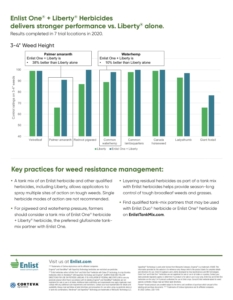
Going forward into 2023, Pioneer will continue to have the current lineup of Xtend A-Series soybeans plus the Enlist E3 soybean technology.
Reminder that the Pioneer Customer Appreciation Supper is this Friday evening, August 19th. Pioneer warehouse – Elgin, NE….5:30-8:30. Bring the family!
Thanks for your time!
Starman Seed Service, Inc.


